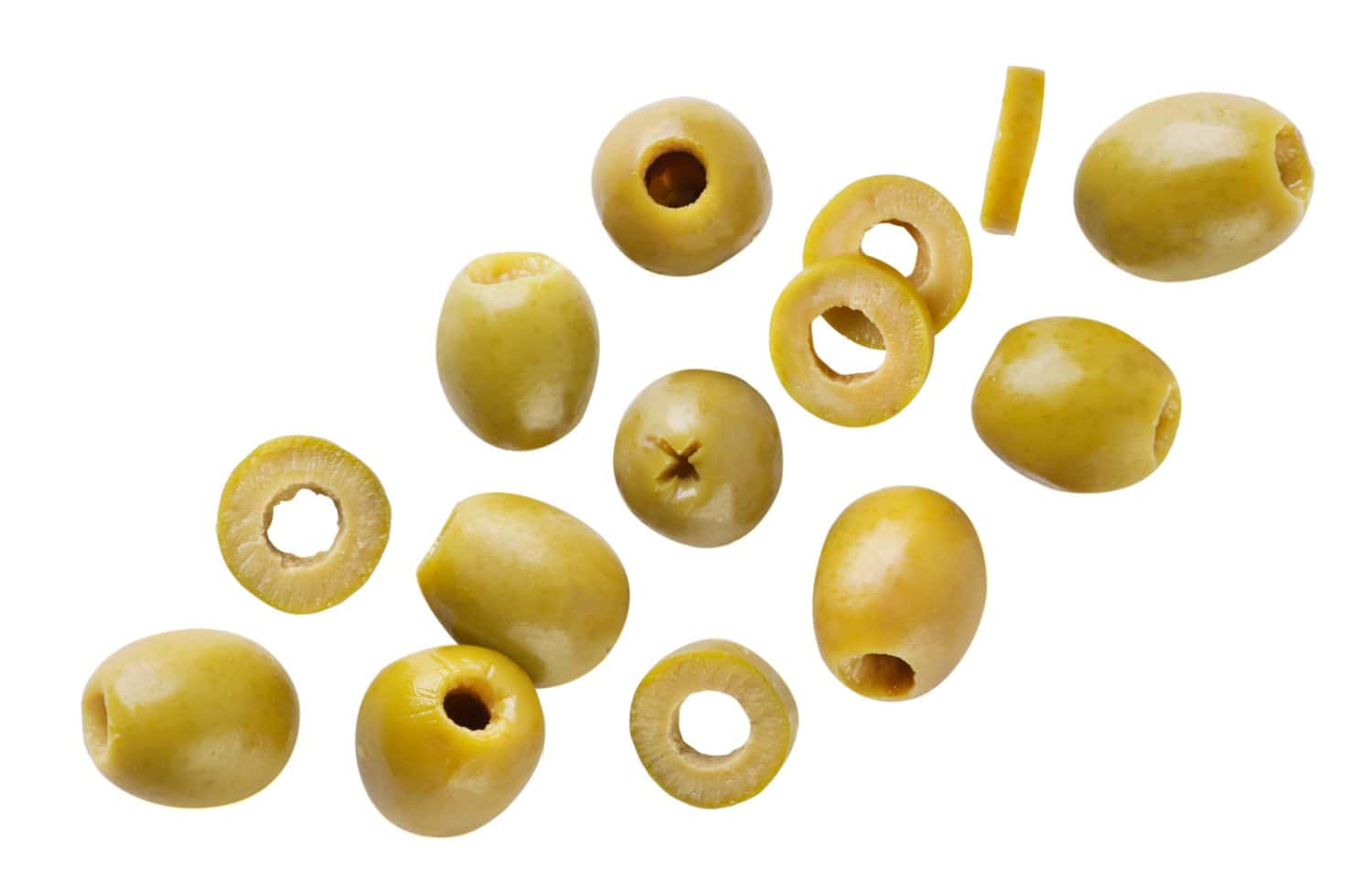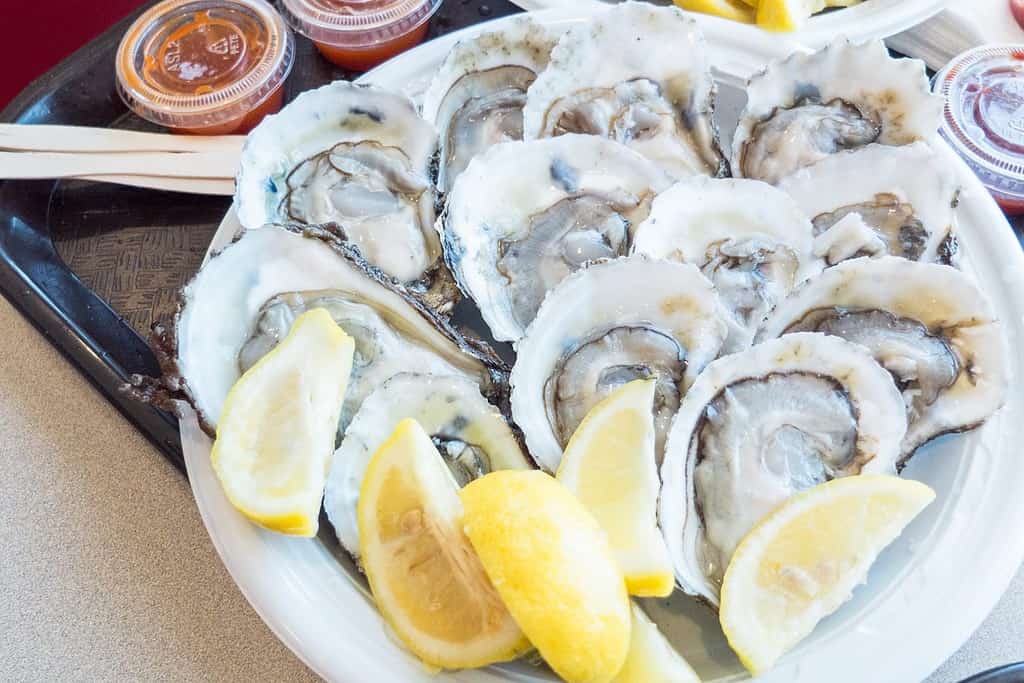A food’s name can potentially tell you a lot about its history, culture, and even flavor. But what about foods that start with a particular letter of the alphabet? Below, we’ll be taking a look at over 40 unique foods that start with the letter O, their uses, their countries of origin, and more.
1. Olive

Olives were first cultivated in the Mediterranean region.
©innakreativ/Shutterstock.com
The humble olive has a distinct flavor and has many great uses. It’s also the source of olive oil. Its scientific or botanical name is Olea europaea, which simply means “European olive.” The plant is mainly cultivated in the Mediterranean region. However, it is also a common crop in other parts of the world, such as Australia, South Africa, and New Zealand. Its primary uses are in Mediterranean cuisine as well as Middle Eastern dishes.
2. Oregano

Oregano can range in flavor from spicy to sweet, depending on the subspecies or strain.
©Volosina/Shutterstock.com
Interestingly, oregano belongs to the mint family of flowering plants, botanical name Lamiaceae. Like olives, it also is native to the Mediterranean area, but it has since spread throughout the planet’s northern hemisphere. Humans worldwide have developed many subspecies and strains of the plant, which vary widely in flavor from straightforwardly bitter and even spicy to more nuanced and sweet. As a culinary herb, it’s incredibly important to Italian cuisine.
3. Opera Cake

Many thin, fluffy layers make up an opera cake.
©etorres/Shutterstock.com
This tasty French dish gets its name from its many thin, fluffy layers that resemble the ascending levels of an opera house. The layers consist of an almond sponge cake (or Joconde in France) that has been soaked in a coffee-flavored syrup, silky chocolate ganache, and French buttercream icing. Atop all of these layers is often a chocolate glaze. The dish’s true roots are a bit uncertain, but it likely originated sometime in the 1950s or ‘60s.
4. Osso Buco

Osso buco is a popular dish in Lombard cuisine.
©8H/Shutterstock.com
Originating from the Lombardy region of France, this dish consists of cross-cut veal shanks. The shanks are then braised with broth, vegetables, and white wine. A common garnish often added to the meal is gremolata, a tangy green sauce made of garlic, parsley, and lemon zest. Nowadays, there are two main types of Osso buco. One of these, the more modern variety, often includes tomatoes, as well as carrots, celery, and onion, while the traditional version omits them.
5. Orange

The orange is a hybrid of the pomelo and mandarin.
©darksoul72/Shutterstock.com
The orange, or the sweet orange (to differentiate it from its cousin, the bitter orange), belongs to the Rutaceae family of flowering plants. Notably, it’s actually a hybrid of the pomelo and mandarin plants. Its true origins are somewhere in Southern China and Northern India. It has been described in ancient Chinese literature as early as 314 BC! Today, oranges are among the most widely cultivated fruits worldwide–and, in our opinion, the tastiest.
6. Oyster

Oysters are highly nutritional and a great source of nutrients such as protein, zinc, and vitamin A.
©Atsushi Hirao/Shutterstock.com
The edible oyster’s scientific name is Ostrea edulis. It also goes by the name European flat oyster. People have cultivated these bivalve mollusks in Europe since prehistoric times. This particular species has a fossil record dating back more than a whopping 15 million years. When they reach full maturity, they average around 2 to 4 inches wide. Interestingly, all edible oysters start their lives as males and can change their sex depending on the temperature of the water around them.
7. Oxtail

There are many unique versions of oxtail soup that are popular throughout China, South
Africa
, and Europe.
©EzumeImages/iStock via Getty Images
Oxtail is exactly what it sounds like on the tin: it’s simply the culinary name for the tail of various types of cattle. Traditionally, however, it originally only referred to the tail of an actual ox. This food starting with O is most commonly prepared via slow-cooking as part of a stew or braised. It also is the base for oxtail soup! Various cultures worldwide, such as Italian, Chinese, and South African, have utilized oxtail in their cuisine.
8. Onion

There are more than 600 unique species of onions today.
©Miss Pop/Shutterstock.com
The common onion, or bulb onion, is the world’s most widely cultivated member of the Allium botanical genus. Other members of the Allium group include shallots, leeks, garlic, and chives. In total, there are hundreds of unique onion species, which makes it one of the largest plant genera on the planet! Swedish biologist Carl Linnaeus first described onions in 1753. However, ancient peoples have likely cultivated them for around 7,000 years. Today, the onion is used in many dishes all around the world, from soups to salads and other entrees.
9. Okra

Okra’s edible green seed pods can be prepared via a wide variety of methods.
©Hari Mahidhar/Shutterstock.com
Okra is a type of flowering plant that belongs to the mallow family, and it’s originally native to East Africa. The vegetable itself is actually an edible seed pod. This food starting with O was first brought to the Americas via the Atlantic slave trade in the 1600s. By the 1700s, the plant was being grown throughout the colonies, with it being incredibly popular and common in the American South by the 1800s. Today, it remains popular in the South, with fried okra being an especially well-loved preparation of the plant.
10. Omelette

Meats, veggies, and cheeses are commonly added to omelets.
©Brent Hofacker/Shutterstock.com
An omelet, or omelet, is a tasty egg-based dish typically fried with butter and oil in a pan. Many ingredients can be added to an omelet, from meats to vegetables and even many types of cheeses. Though they are largely associated with France today, the very first omelets actually likely originated in Persia. It wasn’t until the 16th century that the French word “omelet” began to enter the vernacular.
Even More Foods Starting with O
11. Oatmeal
12. Olallieberry
13. Okonomiyaki
14. Olivet Cendré
15. Oeufs en Meurette
16. Oreillette
17. Olla podrida
18. Olla gitana
19. Orzo
20. Oca
21. Ogo
22. Orach
23. Oroblanco
24. Okroshka
25. Opah
26. Orange Roughy
27. Obwarzanek Krakowski
28.Omaere
29. Ovidur
30. Olomoucké tvarůžky
31. Oltermanni
32. Orda
33. Oscypek
34. Oštiepok
35. Oka
36. Oaxaca Cheese
37. Obatzda
38. Ofe Achara
39. Ofe Owerri
40. Ofe Ujuju
41. Onigiri
42. Ooray
43. Ōgonkan
44. Olivier Salad
The photo featured at the top of this post is © darksoul72/Shutterstock.com
Thank you for reading! Have some feedback for us? Contact the AZ Animals editorial team.







